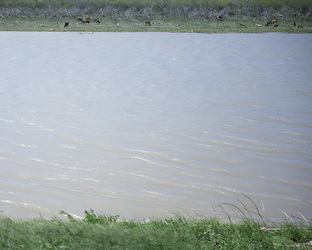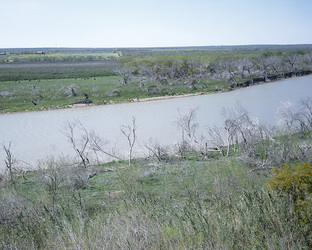RIO GRANDE/RIO BRAVO: THE RIVER RUNS THROUGH IT
The Rio Grande project is about the Rio Grande River as both geographical and political borderline between Texas and Mexico. From Brownsville, in the Gulf of Mexico, to El Paso, the river marks the natural and social division between the two countries.
The water itself is divided in two; half is Texan and half is Mexican. The name of the river changes also: Rio Grande on the Texan side; Rio Bravo on the Mexican side.
This stretch of water has always been strategic in the history of USA and Mexico, and still is.
The Rio Grande River is a place rich with suggestions and contradictions: you can go from areas where you can easily walk along the river and peacefully enjoy an unbounded natural environment, to other areas where the serenity has been shattered by construction of the wall meant to “protect” the border.
There are places where the American side and the Mexican side look very similar to each other, reflecting as a mirror, sometimes looking like one land with no sense of separation at all. In other places the fence puts you in front of the duality between the freedom of nature and the limitations of society.
I focused on the river as a visible but invisible line because, as both a natural and social boundary, it is very symbolic of the barriers that we put between each other as human beings, and of the complicated interactions between people and landscape.
The water itself is divided in two; half is Texan and half is Mexican. The name of the river changes also: Rio Grande on the Texan side; Rio Bravo on the Mexican side.
This stretch of water has always been strategic in the history of USA and Mexico, and still is.
The Rio Grande River is a place rich with suggestions and contradictions: you can go from areas where you can easily walk along the river and peacefully enjoy an unbounded natural environment, to other areas where the serenity has been shattered by construction of the wall meant to “protect” the border.
There are places where the American side and the Mexican side look very similar to each other, reflecting as a mirror, sometimes looking like one land with no sense of separation at all. In other places the fence puts you in front of the duality between the freedom of nature and the limitations of society.
I focused on the river as a visible but invisible line because, as both a natural and social boundary, it is very symbolic of the barriers that we put between each other as human beings, and of the complicated interactions between people and landscape.
4x5 Color Transparencies Film
Archival Inkjet Watercolor Prints
“20 x 24" Image
Edition 1/7 + 3 Artist proofs
2010/2012











